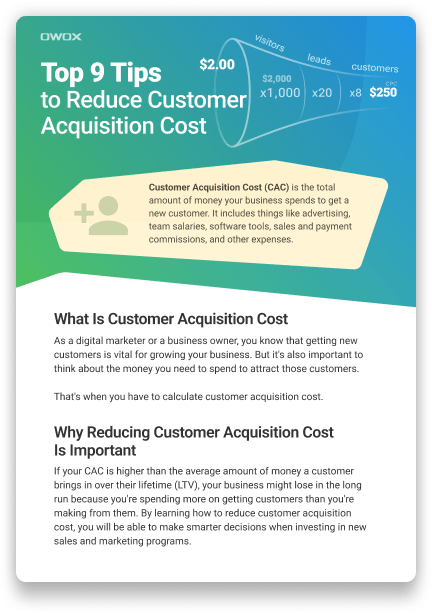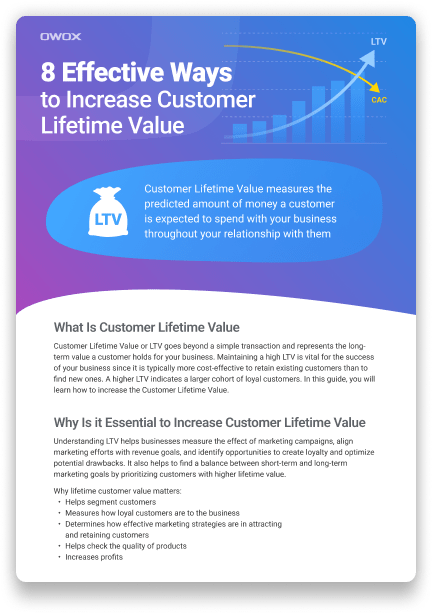Table of contents
- What are Digital Marketing Metrics and KPIs?
- What’s the Difference Between Metrics and KPIs?
- Why are Metrics and Key Performance Indicators in Digital Marketing so Important?
- List of Performance Marketing Metrics and Sales Performance Metrics and KPIs Examples
- Over the Waterfall of Metrics in Digital Marketing
Top 21 Digital Marketing Metrics and KPIs to Measure in 2024
Olha Diachuk, Creative Writer @ OWOX
Without a competent and timely analysis of the main KPIs and metrics of digital marketing web analytics loses its meaning. We’ll go through a few interesting digital marketing formulas that will help you know your marketing flow better. It’s hard to believe, but people may be wrong when assessing their everyday processes.
Let’s check out a few key digital marketing metrics and think over them one month from now/today. Maybe you’ll reveal something important about your practices that you’ve never noticed before.
Note: This list of the most important and used internet marketing metrics and digital KPIs was first published back in 2018 and updated with new context to suit the current state of marketing analytics metrics and trends in 2024.

What are Digital Marketing Metrics and KPIs?
Digital marketing metrics and KPIs (Key Performance Indicators) are ways to measure how well your online marketing efforts are working. Think of them like scorecards for your digital marketing strategies.
Metrics are the specific data points you track, like website visits, social media followers, or email open rates.
KPIs, on the other hand, are the most important metrics that tell you whether you're achieving your marketing goals.
For example, if your goal is to increase sales, the KPI might be the number of online purchases. These metrics and KPIs help you understand what's effective in your digital marketing and what needs improvement, so you can make better decisions and boost your online success.
What’s the Difference Between Metrics and KPIs?
The basic difference is that a metric is something you can count, such as actions or events. Like pressing the Leave a message button. A metric is just a number. And how you interpret this number is up to you.
On the other hand, a Key Performance Indicator (KPI) includes insights. Typically, KPIs have normal values and can tell you about your business if you compare the actual value with the average value. For example, there are typical open rates in email marketing for different industries. Check them before setting your benchmarks.
Aspect | Metrics | KPIs |
Definition | Specific data points used for measurement | Key performance indicators that show if you're meeting your objectives |
Scope | Can be numerous and cover various aspects | Focused on a few critical performance indicators directly tied to goals |
Importance | Provide detailed information | Indicate overall performance and success |
Customization | Can be customized for specific needs | Generally standardized for broader use |
Examples | Website traffic, social media likes | Conversion rate, revenue, customer acquisition cost |
Role | Supporting data for analysis | Main drivers of decision-making |
Alignment with Goals | May or may not align with the goals | Directly aligned with organizational objectives |
Why are Metrics and Key Performance Indicators in Digital Marketing so Important?
You can’t say for sure if your business is performing well unless you look at the numbers. Here are a few reasons why keeping an eye on these digital marketing key metrics and KPIs is so important.
Measuring Performance: Metrics and KPIs in digital marketing provide a way to assess the effectiveness of your digital marketing efforts, helping you understand what's working and what needs improvement.
Data-Informed Decision-Making: These metrics and digital marketing KPIs enable data-driven decision-making by providing actionable insights that guide resource allocation and strategy adjustments.
Goal Tracking: Digital marketing key metrics help you track progress toward your marketing goals, ensuring that you're on the right path to achieving them.
ROI Assessment: These metrics allow you to determine if your marketing investments are delivering a positive return on investment, a crucial consideration for businesses.
Continuous Improvement: Regularly monitoring metrics promotes a culture of continuous improvement, helping you optimize your marketing strategies over time for better results.
What you need to focus on is relevant data that indicates your digital marketing performance. There are a variety of KPIs and metrics for digital marketing that you should track depending on your industry and goals. Today, we’ll look at some of them that apply to most businesses.
Not sure what metrics you need and how to calculate them? We’ve prepared a selection of dashboards that will be useful to every marketer. Just select a template, connect your data, and get a ready-made report on advertising campaigns, sales funnel, ROPO, RFM, LTV, cohort analysis, and more.
Sign up for a demo and we'll show you how to use these templates and get valuable insights from your data.
Mastering Marketing KPIs: How to Evaluate Your Marketing Performance
You'll learn how you can effectively evaluate your marketing performance to fuel your business growth.
Watch the replay
Marketing Ninja @ OWOX
List of Performance Marketing Metrics and Sales Performance Metrics and KPIs Examples
What’s going on with my sales? Is my website effective enough? What’s been the efficiency of our content marketing efforts in the last few months? All of these questions can be answered by marketing and sales performance metrics and KPIs. While marketing and sales are different departments, they are very closely linked. Following are the KPIs and digital metrics that can give a clear picture of your business.
1. Website Metrics
This digital marketing performance metric indicates the total number of visitors to your website over a specific period, providing an overview of your site's reach and audience size.
Bounce Rate: Bounce rate is calculated as the number of single-page visits (where a user views only one page) divided by the total number of visits. The formula is:
It's typically expressed as a percentage.
Average Session Duration: To calculate the average session duration, sum up the total time spent by all visitors on your website during a specific period and divide it by the total number of sessions. The formula is:
These formulas can be applied using web analytics tools like Google Analytics 4, which automatically tracks and calculates these metrics for your website.
2. Search Engine Optimization (SEO) Metrics
SEO metrics are one of the most crucial metrics in digital marketing for evaluating the performance of your website in search engine results and understanding how effectively your SEO efforts are driving organic traffic and improving your website's authority.
Organic Traffic: Organic traffic refers to the number of visitors who arrive at your website through unpaid (organic) search engine results. It indicates the visibility and relevance of your website in search engine rankings.
Keyword Rankings: Keyword rankings track the position of your website's pages in search engine results for specific keywords or phrases. Improved rankings for relevant keywords can lead to increased organic traffic.
Backlinks: Backlinks measure the number and quality of other websites linking to your site. High-quality backlinks from authoritative sources can enhance your website's credibility and improve its search engine rankings.
3. Domain Authority
Domain Authority is a metric developed by Moz that assesses the overall authority and trustworthiness of your website in search engine algorithms. A higher Domain Authority score is generally associated with better search engine rankings.
4. Conversion Rate (CR)
Conversion rate is the simplest but not an unimportant digital marketing performance metric. The conversion rate is the percentage of users that complete a desired action (purchase, download an app, submit a contact form).
You can find the number of conversions and total number of visitors in Google Analytics 4.

Once you’ve set your goals, you can see this visualization on the Reports —> Engagement —> Conversion page.
5. Click-Through Rate (CTR)
Clicks mean purchases to a certain degree. The click-through rate is the ratio of users who click a link to the total number of users who view it.
For instance, in a Google Ads campaign, if your ad is displayed 1,000 times and it receives 100 clicks, your CTR would be 10%. This means that 10% of the users who saw your ad took the desired action of clicking on it. A high CTR indicates that your ad is resonating with your target audience, driving more traffic to your website, and is a valuable KPI to monitor to optimize ad campaigns for better performance.
6. Cost per Click (CPC)
Cost per click or CPC KPI is a performance marketing metric that shows if you can save some money on paid ads. This metric shows how much you pay when your ad is clicked. CPC is used to assess the cost-effectiveness of an ad campaign.
Google Ads shows you this information while calculating the CPC on auctions for your keywords. You can integrate your Google Ads with Google Analytics 4 (GA 4) natively, then complete the integration with other ad services with the help of OWOX BI.
7. Cost per Action (CPA)
Cost per action or CPA is a digital advertising performance metric that shows the cost of completing a desired action. It also helps you to measure the effectiveness of the marketing funnel. It’s totally up to you which action you consider desired — signing up for a newsletter, requesting a callback, or something else.
This simple metric is the basis for CPA marketing, where you pay for each conversion that comes from an affiliate source. The pitfalls of this method are that dishonorable affiliates might try to fool you with traffic.
To avoid this, check our CPA case study.
Close the Loop between Marketing & Revenue
Merge advertising, web analytics, and internal data in one report for a comprehensive overview of your performance
4.9
8. Cost per Lead (CPL)
This is an even hotter KPI than the previous one! Cost per lead is similar to cost per action, except that you pay for the contact information of a person potentially interested in your offer.
To calculate this metric, add all your ad expenditures on the way to registration for gated content, for instance, and divide the total expenditures by the number of acquired leads. This metric will show you if your lead acquisition efforts fall within your budget or if you’re spending too much. Keep in mind that a lead is only halfway to being a client and isn’t even a loyal follower.
9. Customer Acquisition Cost (CAC)
Customer Acquisition Cost (CAC) is a vital digital advertising performance metric that calculates the average cost a business incurs to acquire a new customer. It provides insights into the efficiency and sustainability of marketing and sales strategies.
To calculate CAC, you add up all the costs associated with acquiring customers, including marketing expenses, advertising costs, and sales team salaries, and then divide that total by the number of new customers acquired during a specific period.
For example, if you spent $10,000 on marketing and sales efforts in a month and acquired 100 new customers, your CAC would be $100.
Monitoring CAC helps businesses understand the financial viability of their customer acquisition strategies. A lower CAC is generally more desirable, as it means you are acquiring customers at a lower cost, potentially leading to better profitability. However, what constitutes a "good" CAC for one business may not be the same for another.
Uncover in-depth insights
Top 9 Tips to Reduce Customer Acquisition Cost
Download nowBonus for readers

10. Abandonment Rate
This metric is the percentage of inbound calls that are canceled before connecting with a call center agent or the percentage of abandoned carts in the retail business.
For call centers:
For retail businesses or e-commerce:
A high abandonment rate can be a concern for online retailers, as it indicates that a significant portion of potential customers are leaving the purchase process without converting. To address this, businesses often analyze the reasons for cart abandonment, such as unexpected costs, complicated checkout processes, or security concerns, and implement strategies to reduce this rate. Lowering the abandonment rate can lead to increased sales and revenue in e-commerce.
Hassle-free data analysis and reporting
Easily collect, prepare, and analyze marketing data. Stay on top of your marketing performance
4.9
You can see the positive side of the abandon rate in Google Analytics 4 after setting a conversion goal for the shopping cart page. The best practice is to track the abandon rate depending on industry average values and audience cohorts over time.
11. Return on Ad Spend (ROAS)
Simple and understandable, this is one of the most important key metrics for digital marketing to measure ad performance. Return on ad spend is the amount of revenue your business gets for every dollar spent on ads. Use it as the main metric for each digital marketing campaign and you’ll feel the difference between effective and ineffective campaigns.
12. ROI (ROMI for marketing)
ROI is the queen of KPIs in digital marketing, even among those who have never heard about analytics! Return on investment is a performance metric that’s used to evaluate the efficiency of a particular investment.
You can calculate ROI for almost every process. In most cases, ROI is normalized and must be above 100%. So before you start calculations, find the benchmarks for your particular case. Read more about ROI in our article.
13. Average Revenue Per Account/User/Customer (ARPA, ARPU, ARPC)
Average Revenue Per Account/User/Customer (ARPA, ARPU, or ARPC) is a key financial metric used to measure the average amount of revenue generated by each account, user, or customer over a specific period, usually monthly or annually. This metric is particularly important for subscription-based businesses, software-as-a-service (SaaS) companies, and other subscription models, as it helps assess the financial health and sustainability of the customer base.
Average revenue per account (or per user or customer) shows you the average revenue from an account.
Check your ARPA now if you’re planning to raise prices. Then check it later. If raising prices was a bad idea, you’ll see it in the ARPA — unless the total monthly recurring revenue increases, the ARPA will fall.
14. Time to Payback CAC
This financial metric shows how long it’ll take to earn back marketing costs spent on acquiring a customer. The time to payback CAC metric is particularly important for subscription-based businesses and those with recurring revenue models, especially relevant for SaaS businesses with long sales funnels.
Monitoring Time to Payback CAC is crucial because it helps businesses assess the efficiency of their customer acquisition strategies and the sustainability of their revenue streams. A shorter payback period indicates a faster return on investment for acquiring new customers, which can be vital for business growth and financial stability.
15. Monthly Recurring Revenue (MRR)
The general concept is that MRR is a metric for recurring revenue components of a subscription business. It helps companies predict revenue and realign their sales plans.
MRR as a KPI is often more closely associated with finance, but marketing and sales contribute to MRR growth by acquiring new customers and retaining existing ones.
16. Churn Rate
The churn rate is the percentage of customers or subscribers who discontinue their subscriptions during a given period.
Churn metrics are vital for understanding customer retention and identifying where marketing and sales efforts may need improvement to reduce customer attrition.
17. Revenue-churn
Also known as the MRR churn rate, where MRR is monthly recurring revenue, revenue churn defines the loss in revenue from churned customers and downgraded subscriptions.
18. Share of Market (SOM)
This metric assesses the company's market presence relative to competitors. While marketing often plays a significant role in market share growth, sales strategies can also influence it.
This metric shows how big your share of the market is.
You can calculate the percentage of the market you have and set the right goals to grow. The biggest problem is getting data on sales in the whole market.
19. Share of Wallet (SOW)
Share of Wallet is a digital marketing measurement KPI that shows the portion of a customer's spending going to your company compared to competitors. Both marketing and sales can impact this metric by providing value and retaining customers.. You can get this data through marketing investigations or focus groups. Focus groups are a tough but interesting way to collect data because your clients will tell you insights that you could never have imagined! Just take the first step to meet them.
Let’s say Ann spent $20 on your handmade cosmetics this month while she spent $120 on cosmetics in general. Your SOW would be 20/120 × 100% = 16.6%. Not as high as expected!
20. Customer Retention Rate (CRR)
How long do people keep returning to you? Or do they just buy and say goodbye? Getting new customers is much more expensive than reactivating existing customers. The customer retention rate is also called reversed customer churn.
The perfect customer retention rate is 100%. It means that customers are loyal and stay with you for a while. But if it starts decreasing, pay more attention to your customer service. It is worth trying to keep this digital marketing KPI high.
21. Customer Lifetime Value (CLV)
Customer lifetime value can be historical (the sum of all profits from the purchases a customer has made) or predictive (the total revenue your business expects to get from the relationship with this customer).
LTV as a metric is crucial for guiding marketing and sales efforts, helping businesses make informed decisions about customer acquisition, retention, and loyalty programs. It highlights the importance of nurturing long-term customer relationships for sustainable revenue growth.
Uncover in-depth insights
8 Effective Ways to Increase Customer Lifetime Value
Download nowBonus for readers

Over the Waterfall of Metrics in Digital Marketing
Metrics in digital marketing and KPIs mentioned in the article are just the tip of the iceberg of measuring your efforts. But getting acquainted with online marketing metrics is necessary so you aren’t surprised like the crew of the Titanic when you meet difficulties in the open sea of business.
Analyze your marketing efficiency, find the growth areas, increase ROI.
Yes, its a lot of metrics and KPIs to measure, and multiple dashboards can be hard to deal with. At OWOX BI, you can integrate all your marketing efforts in one place, and look at the important digital marketing metrics and KPIs in one dashboard.
Save 70+ hours on data preparation
Spend time reaching your monthly KPIs instead of collecting the data or building reports
4.9
FAQ
-
How can you improve your digital marketing metrics?
Improving your digital marketing metrics requires continuous monitoring and analysis of your KPIs, testing and optimizing marketing strategies, staying up-to-date with industry trends and best practices, and leveraging data-driven insights to make informed decisions. -
How do you choose the right KPIs for your business?
Choosing the right KPIs for your business requires identifying your goals and objectives, understanding your target market and the customer journey, and selecting KPIs that align with your business strategy and marketing campaigns. -
What are some common digital marketing metrics?
Common digital marketing metrics include website traffic, engagement rate, conversion rate, ROI, and customer lifetime value.













